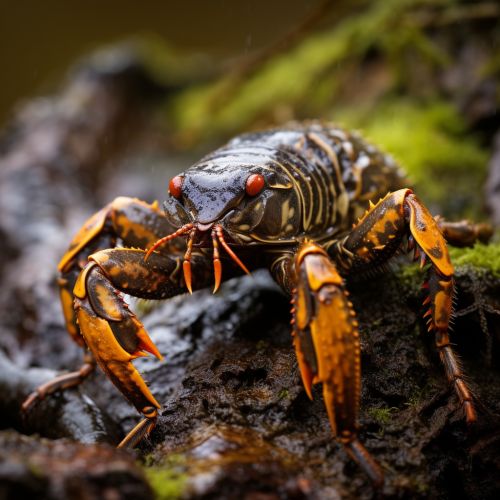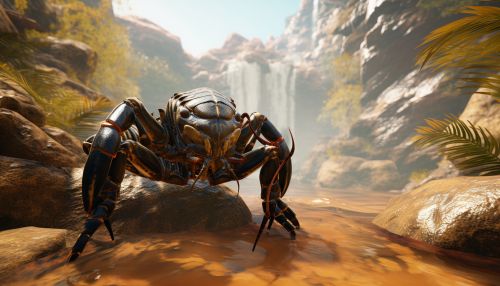Scorpions
Introduction
Scorpions are a type of arachnid that belong to the order Scorpiones. They are known for their elongated bodies and venomous stingers, which they use primarily for hunting and self-defense. Scorpions are found on all continents except Antarctica, and they inhabit a wide range of environments, including deserts, forests, and grasslands.


Anatomy and Physiology
Scorpions have a complex anatomy that is highly adapted to their predatory lifestyle. Their bodies are divided into two main parts: the cephalothorax (or prosoma) and the abdomen (or opisthosoma), which is further divided into the mesosoma and the metasoma.
Cephalothorax
The cephalothorax is covered by a carapace and contains the scorpion's eyes, mouthparts, and pedipalps. Scorpions have two main eyes on top of their carapace and usually two to five pairs of lateral eyes along the sides. Despite having multiple eyes, their vision is relatively poor, and they rely more on their other senses, particularly touch and vibration.
The pedipalps are large, claw-like appendages that scorpions use for capturing prey and for defense. The claws (or chelae) at the end of the pedipalps vary in size and shape, depending on the species and its particular hunting strategy.
Abdomen
The abdomen consists of the mesosoma and the metasoma. The mesosoma contains the scorpion's respiratory and digestive organs, as well as a pair of comb-like sensory structures called pectines. The metasoma, often referred to as the tail, is a segmented, flexible appendage that ends in the scorpion's most recognizable feature: the stinger, or telson.
The telson contains a pair of venom glands and a sharp, curved aculeus that the scorpion uses to inject venom. The potency of the venom varies widely among species, from relatively harmless to humans to potentially lethal.
Behavior and Ecology
Scorpions are predominantly nocturnal creatures, spending the day hiding under rocks, in crevices, or in burrows to avoid the heat and emerge at night to hunt. They are opportunistic predators, feeding on a variety of insects, spiders, and other small animals. Some larger species are known to prey on small vertebrates, such as lizards and mice.
Scorpions have a unique mating ritual, which involves a dance-like sequence of movements known as the "promenade à deux". After mating, the female usually gives birth to live young, which she carries on her back until they undergo their first molt.
Scorpions have a number of natural predators, including birds, centipedes, lizards, mice, possums, and rats. They are also preyed upon by other scorpions. To defend themselves, scorpions use their pincers and stingers, and some species can also spray venom.
Classification and Diversity
There are over 2,500 described species of scorpions, grouped into 22 families. The three most diverse families are the Buthidae, Scorpionidae, and Diplocentridae. The Buthidae family, which includes the deadly deathstalker and Indian red scorpion, is known for its highly venomous species.
Scorpions have a fossil record dating back to the Silurian period, over 430 million years ago. They are one of the oldest land-dwelling arthropods and have changed little in appearance over their long evolutionary history.
Human Interaction
Scorpions are often feared due to their venomous sting, but only about 25 species are known to have venom capable of killing a human. In many parts of the world, scorpions are considered pests and are often killed due to their potential threat.
Despite their fearsome reputation, scorpions also have a significant role in human culture, featuring in myths, folklore, and symbolism across many different societies. In modern times, they are sometimes kept as pets, and their venom is used in medical research for the development of drugs for various conditions, including autoimmune diseases and cancer.
Conservation
While many species of scorpions are common and not considered threatened, some are rare and protected under national legislation. Habitat loss due to human activity is the main threat to scorpions. Climate change may also impact scorpion populations, although the exact effects are not well understood.
